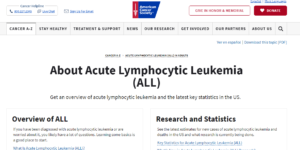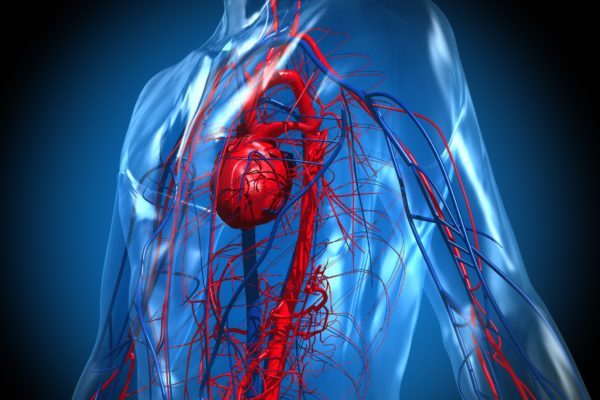
American Cancer Society – About Acute Lymphocytic Leukemia (English)
Acute leukaemia is a rapidly progressing cancer that starts in blood-forming tissue, such as bone marrow, and causes large numbers of white blood cells to be produced and enter the blood stream. Acute leukaemia occurs when a haematopoietic stem cell undergoes a malignant transformation into a primitive, undifferentiated cell with abnormal longevity. This results in the bone marrow cells not maturing properly. Immature leukaemia cells continue to reproduce and build up. The cancerous blood cells then overrun the normal blood cells in the body. This interferes with the body's ability to fight infections, control bleeding and deliver oxygen to normal cells. The cancerous cells can also invade the spleen, liver and other organs.
In most cases, acute leukaemia can be classified according to the lineage of the malignant cells that grow uncontrolled, which may be myeloid or lymphoid.
Forms of acute leukaemia include:
Acute lymphoblastic leukaemia (ALL) is a cancer of the lymphoid line of blood cells characterised by the development of large numbers of immature lymphocytes. Symptoms may include: fatigue, pale skin colour, fever, easy bleeding or bruising, enlarged lymph nodes, bone pain. The liver and spleen may also be palpable.
As an acute leukaemia, ALL progresses rapidly and is typically fatal within weeks or months if left untreated. ALL occurs most commonly in children, particularly in those between the ages of two and five.
Acute myeloid leukaemia (AML) is a cancer of the myeloid line of blood cells, characterised by the rapid growth of abnormal cells that build up in the bone marrow and blood and interfere with normal blood cells. It starts in early forms of myeloid cells. These cells create white blood cells (other than lymphocytes), red blood cells or platelet-making cells (megakaryocytes). Myeloid leukaemias are also known as myelocytic, myelogenous and non-lymphocytic leukaemias. Symptoms arise as healthy, normal blood cells are replaced with leukaemic cells. Early signs are often non-specific and include fever, fatigue, anaemia, shortness of breath, easy bruising or bleeding, pale complexion and an enlarged spleen. Swelling of the gums can also occur.
As an acute leukaemia, AML progresses rapidly and is typically fatal within weeks or months if left untreated. It most commonly occurs in older adults.
All leukaemia types are diagnosed by examining blood samples and bone marrow. Symptoms of acute leukaemia may occur suddenly or may have been present for weeks or months before diagnosis. While many symptoms can be found in common illnesses, persistent or unexplained symptoms raise the suspicion of cancer. Because many features on the medical history and exam are, mostly, not specific to acute leukaemia, further testing is often needed. A complete blood count will show the levels and types of:
A large number of white blood cells and lymphoblasts in circulating blood can be suspicious for ALL, because they indicate a rapid production of lymphoid cells in the marrow. A normal or high number of white blood cells can also be observed in both ALL and AML, combined with a low number of red blood cells and platelets, as these types of cells are replaced by leukaemic cells in the bone marrow. Although white blood cells remain within range, or even high, it should be noted that these are non-functional, leukaemic white blood cells that cannot contribute to the patient’s immune response as a result. This explains why many patients with leukaemia experience recurrent infections. The high numbers typically point to a worse prognosis.
Bone marrow tests and other tests will give more information to confirm the diagnosis of leukaemia. Blood smear analysis may be done to examine the shape of the blood cells. Genetic testing may be done to identify chromosomes or genes involved with leukaemia.
The aim of treating ALL is to induce a lasting remission, defined as the absence of detectable cancer cells in the body. This usually means less than 5% blast cells in the bone marrow. However, it is important to understand that patients with different ALL subtypes may have different outlooks and responses to treatment.
The chance of having a positive treatment response depends on the patient’s age and the white blood cell volume at time of diagnosis. Patients younger than 9 years, with low white blood cell levels are more likely to have a positive response. The likelihood of initial remission is more than 95% in children and 70 to 90% in adults. Of children, 70% or more have a continuous disease-free survival for 5 years and appear cured. Of adults, 30 to 40% has a continuous disease-free survival for 5 years.
The treatment of acute lymphocytic leukaemia consists of three to four phases:
People who experience a relapse after initial treatment have a poorer prognosis than those who remain in complete remission after induction therapy. When relapses do occur, patients should be trialled on re-induction chemotherapy followed by allogeneic bone marrow transplantation.
Targeted therapy is an emerging and currently evolving area of therapeutic intervention for ALL. For eligible patients, ALL can be treated with the following types of medications:
The first-line treatment of AML consists primarily of chemotherapy and is divided into two phases: induction and post-remission (or consolidation) therapy:
Haematopoietic stem cell transplantation is usually considered if induction chemotherapy fails or after a patient relapses. Patients who have not responded to treatment and younger patients who are in remission but at a high risk of relapse (generally identified by high-risk molecular or chromosomal abnormalities) may be treated with high-dose chemotherapy or stem cell transplantation.
Targeted therapy is also an emerging and currently evolving area of therapeutic intervention for AML. For eligible patients, AML can be treated with the following types of medications:



